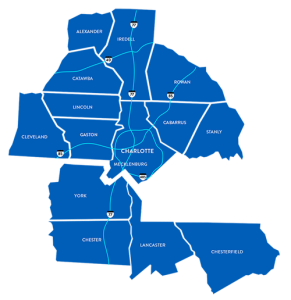Who’s moving here | A closer look at population trends in the Charlotte Region

Introduction
The Charlotte Region is growing at an expedited pace, with about 113 people moving into the region every day. This growth is in line with historical trends as well. Beginning in the 1990s the region has seen dramatic growth, with population increasing by more than 15% each decade. The Charlotte Region becoming a destination for movers bodes well for the business community, as a higher population means more potential talent and a larger customer base. However, this high growth also begs the question: Is it sustainable?
Outlook
In terms of sustainable growth, the Charlotte Region does have one key advantage among many of its key peer competitor metros. About 2/3 of people who moved into the Charlotte metro during the 2010s were of prime-working age (age 25-54) as of 2020.
These prime-aged workers come from a variety of places. The largest subset of movers in recent years has been from New York City, averaging about 6,500 movers into the Charlotte Region every year. Other notable locations where people are moving from include, Miami (1,700), Winston-Salem (1,700), and Washington D.C. (1,500). The most prevalent theme in this trend is that the Charlotte Region offers substantially lower cost-of-living options than three out of four of these metro areas. Along with the lower cost of living, the region also offers ample professional pathways. For example, a banker from New York may select the Charlotte Region as their skills will be easily transferable and the power of their dollar will increase. A worker in the manufacturing industry may seek out increased job and advancement access in their move to the region.
The region currently offers many opportunities and options for those in the prime working-age group. For instance, there are over seventy-five breweries, including the number one ranked beer garden in the United States (USA Today 2023). There are more than 200 parks in the region, providing easy access to tennis, swimming, golf, greenways, biking, fishing, pickleball, and more. Additionally, LendingTree recently ranked Charlotte as the number two best city in the country to start a small business. The opportunity to both grow personally and professionally has been a key driver in attracting the primary working-age demographic.
Recommendations
Regional growth has been driven in large part by in-migration of those around the country from a young demographic. Going forward, the region is projected to continue growth, but be even more dependent on migration to attract those in key demographic groups. Placemaking will be arguably the most important tool regional players have at their disposal to ensure the Charlotte Region remains a top choice for talent. The region has already displayed its dedication to placemaking efforts. Regional examples include active or planned social districts in seven of 14 counties, public transportation, innovation, and more.
Quality of Life: Investment will follow where talent congregates. Investing in quality-of-life such as recreational opportunities, education, culture and arts, and childcare will allow the region to remain a destination of choice.
For an in-depth look at the Charlotte Region’s population and growth, please see The CLT Alliance Research Team’s publication: “Three Decades of High Growth and Continuing: How the Charlotte Region has grown and how to keep it going.”
Provided by the Charlotte Regional Business Alliance
 Previous
Previous


